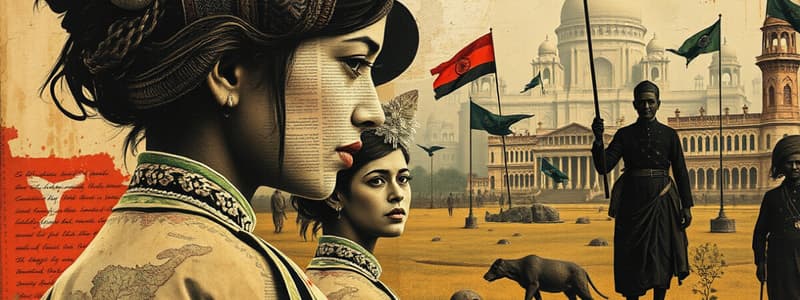Podcast
Questions and Answers
What was one major outcome of the Revolt of 1857?
What was one major outcome of the Revolt of 1857?
- Formation of a new Indian dynasty
- End of British rule in India
- Immediate independence for India
- Increase in British control over India (correct)
What are the Directive Principles of State Policy in the Indian Constitution?
What are the Directive Principles of State Policy in the Indian Constitution?
Guidelines for the state to ensure social and economic justice.
Raja Ram Mohan Roy was an advocate for child marriage.
Raja Ram Mohan Roy was an advocate for child marriage.
False (B)
The Preamble of the Indian Constitution declares India to be a ______ republic.
The Preamble of the Indian Constitution declares India to be a ______ republic.
Match the following types of resources with their examples:
Match the following types of resources with their examples:
Which of the following is a factor affecting natural vegetation?
Which of the following is a factor affecting natural vegetation?
Flashcards are hidden until you start studying
Study Notes
Causes of the Revolt of 1857
- Multiple factors including political, economic, military, and social grievances led to widespread discontent among Indians.
- Resentment towards British policies, including land revenue systems and the annexation of Indian states, fueled anger.
- The introduction of the Enfield rifle, coupled with rumors of animal fat used in cartridges, provoked a strong reaction among sepoys.
Beginning and Spreading of the Revolt of 1857
- The revolt commenced on May 10, 1857, in Meerut, spreading rapidly to Delhi, Kanpur, Lucknow, and other regions.
- Diverse participation included sepoys, local rulers, and common citizens united against British rule.
- Major leaders emerged from different backgrounds, including Bahadur Shah II, Rani Lakshmibai, and Tantia Tope.
The Civil Rebellion and Separation of the World
- The revolt represented a unified front of various Indian classes and communities against colonial rule.
- It marked a significant turning point in Indian history, leading to the end of the British East India Company's rule and the commencement of direct British governance.
Failure of the Revolt
- Lack of coordination and unified strategy contributed to the failure of the revolt.
- The British forces utilized superior military technology and organizational skills to suppress the rebellion.
Nature of the Revolt
- The revolt had aspects of both nationalistic and religious motives.
- It was characterized by violence, riots, and atrocities committed by both British and Indian factions.
Effects of the Revolt
- The revolt resulted in significant political changes, including the dissolution of the East India Company in 1858.
- It led to the establishment of direct British rule, known as the British Raj, and changes in administrative policies.
Condition of Women
- Raja Ram Mohan Roy advocated for women's rights, promoting education and social reform.
- Campaigns against child marriage and support for women's education gained traction in Maharashtra and Bengal.
Land Resources and Use
- Issues of soil degradation and conservation were prominent due to extensive agricultural practices.
- Landslides in India highlighted the vulnerability of land resources to natural and human-induced factors.
Water Resources in India
- Water resources are critical for agriculture, drinking, and industry in India.
- Conservation efforts aim to address challenges related to water scarcity and pollution.
Importance of Natural Vegetation and Wildlife
- Natural vegetation plays a crucial role in maintaining ecological balance and supporting biodiversity.
- Wildlife conservation efforts are necessary to protect endangered species and natural habitats.
Factors Affecting Natural Vegetation
- Climate, soil type, topography, and human activities significantly influence the distribution and classification of natural vegetation.
- Fire is a natural factor that can impact vegetation growth and regeneration.
The Preamble of the Indian Constitution
- Serves as an introductory statement, outlining the guiding principles and values of the Constitution.
- Emphasizes justice, liberty, equality, and fraternity as foundational elements for governance.
Transformation of the Constitution into Law
- The Constitution embodies the legal framework governing India, with the Preamble reflecting its core ethos.
Fundamental Rights and Directive Principles
- Fundamental Rights guarantee individual freedoms and legal equality.
- Directive Principles of State Policy provide guidelines for the government in policy-making to promote social welfare.
Fundamental Duties
- Outlines the responsibilities of Indian citizens towards the nation and society.
The Parliament System in India
- India's Parliament consists of two houses: Lok Sabha (House of the People) and Rajya Sabha (Council of States).
- Plays a crucial role in legislation, representing the electorate, and overseeing the government.
Role of Parliament and Types of Bills
- Parliament enacts laws, discusses policies, and holds the government accountable.
- Different types of bills include ordinary bills, money bills, and constitutional amendment bills, each with specific procedures for passage.
Accountability of the Government
- Mechanisms in place to ensure government accountability include parliamentary questioning, annual budgets, and public debates on national issues.
Studying That Suits You
Use AI to generate personalized quizzes and flashcards to suit your learning preferences.




